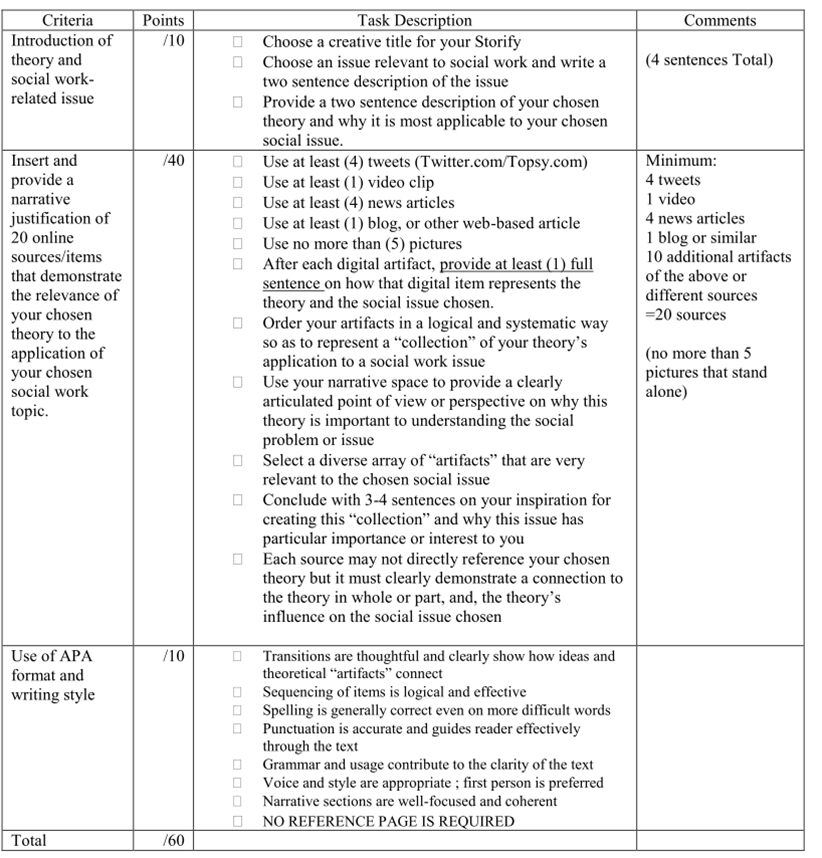#BPD2014 Presentation on Teaching Professional Social Work Skills with Twitter
I am attending the 2014 annual meeting for the Association of Baccalaureate Social Work Program Directors in Louisville, KY. Today is Day 1 of the conference for me, and I’m presenting with Dr. Jimmy Young of the University of Nebraska at Kearney (@Jimmysw) about using Twitter in the classroom. We presented this information at CSWE’s annual program meeting back in October, and the purpose of this post is to provide supplemental information for today’s presentation. If you are attending the conference, please join us in Room Kentucky D at 11:15 AM in the conference venue. Or follow our live demo on Twitter starting at 11:45 AM EST with the hashtag #swktweets.
Using Storify in the Classroom: A Student’s Perspective from Natalie Savoy
Back in January, Dr. Jamie Mitchell from Wayne State University wrote about an assignment for her Human Behavior in the Social Environment Theory class that incorporated Storify, a social media platform that allows users to curate a digital narrative about any topic. The assignment required students to articulate how a theory of their choosing could be applied to a real-world, under-served population or problem of interest using Storify. As a follow-up to Dr. Mitchell’s post, I asked one her MSW students, Natalie Savoy, to share her thoughts on the assignment, what it was like to use social media in the classroom and how social media might be incorporated in her future role as a social worker. Here are Natalie’s responses to my questions:
What was your initial reaction to using social media for an assignment in your Human Behavior in the Social Environment Theory course?
Podcasting for Social Work Students, Part 3 – Advice for designing the assignment from Jonathan Singer
 One of the experts in social work podcasting is Jonathan Singer who runs the Social Work Podcast. He has been podcasting since 2007, and the goal of his work is to disseminate research by and for social workers to improve their practice and outcomes for clients. I spoke with Jonathan about his thoughts on working with students to develop their own podcasts and he recommended educators considering the following three points as they develop podcast assignments:
One of the experts in social work podcasting is Jonathan Singer who runs the Social Work Podcast. He has been podcasting since 2007, and the goal of his work is to disseminate research by and for social workers to improve their practice and outcomes for clients. I spoke with Jonathan about his thoughts on working with students to develop their own podcasts and he recommended educators considering the following three points as they develop podcast assignments:
Podcasting for Social Work Students, Part 2 – Why use podcasting in the classroom
 In my last post, I shared the basic mechanics of a podcasting assignment that has been a regular in my BSW marco-level practice course since 2011. While the post gives details about how such an assignment could be structured, it doesn’t really address why an educator would want to add a podcast assignment to their course? Changing assignments and adding technology to the classroom can be very challenging and sometimes involves a steep learning curve for the instructor and the students.
In my last post, I shared the basic mechanics of a podcasting assignment that has been a regular in my BSW marco-level practice course since 2011. While the post gives details about how such an assignment could be structured, it doesn’t really address why an educator would want to add a podcast assignment to their course? Changing assignments and adding technology to the classroom can be very challenging and sometimes involves a steep learning curve for the instructor and the students.
Podcasting for Social Work Students, Part 1 – Describing the Assignment
One of my favorite technology-based assignments is the student-created podcast in my BSW macro social work class. My motivation for this assignment originated several years ago from a very selfish desire to grade something beside another written research paper. I was not looking to eliminate writing from my courses or minimize its importance for college students and professional social workers. I wanted another way meet the needs of an organizational assessment assignment that was engaging and challenging for the students (and for me) in a course that already had two major writing assignments. The idea for a podcast assignment came from a colleague in the English Department who asked students in introductory writing classes to create a podcast instead of a paper and then write a self-reflection about the process. He contended that the students had to complete the same amount of research and apply the same critical thinking skills to complete the podcast as writing a paper. He convinced me to try it, arguing if the assignment bombed I could easily go back to a written paper and quietly ignore any comments on my student evaluations. Seven semesters later, podcasts have become an integral assignment in my course.
desire to grade something beside another written research paper. I was not looking to eliminate writing from my courses or minimize its importance for college students and professional social workers. I wanted another way meet the needs of an organizational assessment assignment that was engaging and challenging for the students (and for me) in a course that already had two major writing assignments. The idea for a podcast assignment came from a colleague in the English Department who asked students in introductory writing classes to create a podcast instead of a paper and then write a self-reflection about the process. He contended that the students had to complete the same amount of research and apply the same critical thinking skills to complete the podcast as writing a paper. He convinced me to try it, arguing if the assignment bombed I could easily go back to a written paper and quietly ignore any comments on my student evaluations. Seven semesters later, podcasts have become an integral assignment in my course.
Using Storify to Explore Theory in the MSW Classroom by Dr. Jamie Mitchell
Dr. Jamie Mitchell is an Assistant Professor of Social Work at Wayne State University. In this blog post, Dr. Mitchell writes about how she incorporated Storify into a theory-based assignment for an MSW class last semester.
When I realized this past summer that a standardized core assignment in my regular Human Behavior in the Social Environment course had been changed in a way that limited the ability of students to explore a theory of their choosing during the semester, I began testing educational technology tools as a means of restoring that opportunity in a fresh way. I know from experience that some MSW students may view social and developmental theory as abstract and somewhat dated; and I work incredibly hard to highlight the relevance of having a strong theoretical foundation to praxis. It’s important to me that students connect with and write about at least one theory that engages them personally, leading me to develop this new assignment centered on Storify. Storify is a website that allows one to curate a digital narrative on any topic using an integrated social media search engine to locate sources such as tweets, blog posts, YouTube videos, and Google images. That “story” can then be published publicly and shared on other social media platforms.
My goal in developing this assignment was to give students an opportunity to articulate how a theory of their choosing could be applied to a real-world underserved population or problem of interest. Before the course began, I developed my own test Storify that could serve as an example to students and used it to develop a detailed rubric.
From the first day of class I introduced the new assignment and fielded questions from anxious students who were not comfortable with social media. To provide support for adopting Storify, I created a folder on my course website with existing tutorial videos and fact sheets on using Storify, and I developed my own resource for students on how to integrate a variety of content using bookmarklets to capture content around the web to import into Storify. I also worked through any glitches with students as they experimented with the platform and reserved a few minutes at the end of each class to demonstrate Storify functionality throughout the semester.
I was beyond impressed with how invested students were in creating high-quality digital narratives. The majority of students included more sources than were required, and went further in contextualizing how each source contributed to an understanding of the theory’s application to the issue or population than was required by the assignment rubric. Students also chose topics that were deeply personal to them and incredibly germane to the field of social work; covering topics such as human trafficking, school bullying, rape culture, racial profiling, immigrant experiences, inner city poverty, and LGBTQ empowerment. I used my own twitter account to share student projects, even tweeting prominent authors like Dr. Brené Brown when students utilized the Shame Resilience Theory she pioneered. I consider this initial foray into employing Storify as a course assignment to be a resounding success!
I would advise instructors who are interested in developing an assignment with Storify to familiarize themselves with the variety of existing resources such as free tutorial videos (Storify Guided Tour and Getting Started) and tip sheets, to experiment with the service themselves, and to explore the wealth of existing Storify stories for inspiration. Storify is free, intuitive, and user-friendly but it can be optimized by using additional strategies. For example, Google Chrome offers a bookmarklet or browser extension for Storify that allows users to bookmark content around the web and store it in a collection within Storify for later use. The website Topsy allows one to search for tweets by key words and hashtags as far back as two years, well beyond the six months that Twitter archives. Students may also find it useful to know that in addition to using the internal search engine within Storify, and using a bookmarklet to capture outside content, they can copy and paste the URL of any webpage into Storify to import content.
I’m excited about the possibilities for integrating Storify in other ways in my MSW classroom. This refreshing platform has proven to be a reliable and creative social media tool for encouraging students to research, contextualize, and curate content. Below are just a few examples of Storify submissions by my MSW students:
Feminist Theory, Slut Shaming, and Rape Culture by whitentonm
Racial Profiling: Do I Look Suspicious? by Tony Theel
Prison: The New Slavery by MStellini
Women in Sports: Woman first, athlete second by Natalie Savoy
Opening Our Eyes To The Truth About Older Adult Abuse by Melissa Stumpo
The Disney Princess Effect on Young Girls and Feminist Theory by sternb13
Walking the Tightrope of Motherhood by Ellen Coleman
**Note, Storify is a public domain and students are aware that all submissions are public until removed**
How to cite this post:
Mitchell, J. (2014, January 5). Using Storify to Explore Theory in the MSW Classroom by Dr. Jamie Mitchell [Blog Post]. Retrieved from https://laureliversonhitchcock.org/2014/01/05/using-storify-to-explore-theory-in-the-msw-classroom/.





